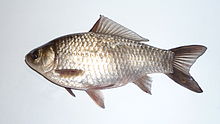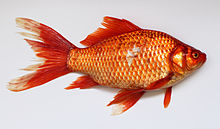| Prussian carp | |
|---|---|
 | |
| Scientific classification | |
| Kingdom: | Animalia |
| Phylum: | Chordata |
| Class: | Actinopterygii |
| Order: | Cypriniformes |
| Family: | Cyprinidae |
| Subfamily: | Cyprininae |
| Genus: | Carassius |
| Species: | C. gibelio |
| Binomial name | |
| Carassius gibelio (Bloch, 1782) | |
| Synonyms | |
| Carassius auratus gibelio | |
The Prussian carp, silver Prussian carp or Gibel carp (Carassius gibelio), is a member of the family Cyprinidae, which includes many other fish, such as the common carp, goldfish, and the smaller minnows. It is a medium-sized cyprinid, and does not exceed a weight of 3 kilograms (6.6 lb) and a length of 45 centimetres (18 in). They are usually silver, although other color variations exist. They are omnivorous and feed on plankton, invertebrates, plant material and detritus. Originally from Siberia, they have been introduced to and are now inhabiting lakes, ponds, and slow-moving rivers throughout Europe, North America, and Asia.[1][2][3][4]
Prussian carps are highly invasive fish species in areas outside its native range. They reproduce and spread rapidly. In 2020 scientists demonstrated that a small proportion of fertilized Prussian carp eggs ingested by waterfowl survive passing through the digestive tract and hatch after being retrieved from the feces.[5][6] Birds exhibit strong preference for fish eggs, while cyprinids produce hundreds of thousands of eggs at a single spawning event. These data indicate that despite the low proportion of eggs surviving the digestive tract of birds, endozoochory might provide a potentially overlooked dispersal mechanism of Prussian carps. If proven under natural circumstances, endozoochorous dispersal of invasive fish could be a strong conservation concern for freshwater biodiversity.
Description

The Prussian carp is a deep-bodied, robust fish which resembles the crucian carp (Carassius carassius) and grows to about 10 to 35 cm (4 to 14 in) in length. Its scales are larger than those of the crucian carp, and it typically has 27 to 32 scales along the lateral line, whereas the crucian carp usually has between 31 and 35. The species is silvery, sometimes with a faint golden tinge, while the crucian carp has a burnished gold appearance. The Prussian carp's tail is more deeply forked than that of the crucian carp.[7]
References
- ^ "Carassius gibelio, Prussian carp : fisheries". www.fishbase.in.
- ^ "Data Use Agreement - GBIF Portal". Data.gbif.org. 2007-02-22. Retrieved 2010-07-29.
- ^ "Archived copy" (PDF). Archived from the original (PDF) on 2010-08-12. Retrieved 2009-04-28.
- ^ Brykov, Vl. A.; Polyakova, N. E.; Skurikhina, L. A.; Dolganov, S. M.; Eliseikina, M. G.; Kovalev, M. Yu. (2002). "Journal Article". Russian Journal of Genetics. SpringerLink. 38 (10): 1176–1180. doi:10.1023/A:1020604905154. S2CID 11234180.
- ^ "Experiment shows it is possible for fish to migrate via ingestion by birds". phys.org. Retrieved 5 July 2020.
- ^ Lovas-Kiss, Ádám; Vincze, Orsolya; Löki, Viktor; Pallér-Kapusi, Felícia; Halasi-Kovács, Béla; Kovács, Gyula; Green, Andy J.; Lukács, Balázs András (18 June 2020). "Experimental evidence of dispersal of invasive cyprinid eggs inside migratory waterfowl". Proceedings of the National Academy of Sciences. 117 (27): 15397–15399. doi:10.1073/pnas.2004805117. ISSN 0027-8424. PMC 7355035. PMID 32571940.
- ^ "Prussian carp: Carassius gibelio". NatureGate. Retrieved 14 December 2013.